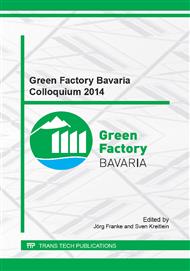[1]
Information on http: /www. bdguss. de/branche/rolle-bedeutung/, 17. 07. (2014).
Google Scholar
[2]
A. Ringleb, S. Hirschberg, W. Schlüter, D. Schneider, G. Pröbstle, A. Dentel, W. Stephan, Rationeller Energieeinsatz in der aluminiumverarbeitenden Industrie, GIESSEREI. 100 (06/2013) 74-77.
Google Scholar
[3]
Information on http: /www. effguss. bdguss. de/, 17. 07. (2014).
Google Scholar
[4]
P. Reichen, Zukunft der Leichtmetalldruckgießerei – Kosten- und ressourceneffizienter Druckguss aus Sicht eines Maschinenherstellers, GIESSEREI. 101 (01/2014) 76-81.
Google Scholar
[5]
Information on http: /www. forenergy. de/, 17. 07. (2014).
Google Scholar
[6]
Information on http: /www. greenfactorybavaria. net/, 17. 07. (2014).
Google Scholar
[7]
A. Pithan, O. Lemański, S. Geisler, G. Röders, Handlungsfeld Ofenkonzepte – Technologien und Organisation, in: C. Herrmann, H. Pries, G. Hartmann (Eds. ), Energie- und ressourceneffiziente Produktion von Aluminiumdruckguss, Springer-Verlag, Berlin, 2013, pp.107-125.
DOI: 10.1007/978-3-642-39853-7_5
Google Scholar
[8]
W. Stephan, K. Zitzmann, G. Pröbstle, J. Kapischke, Effiziente Energienutzung in Nicht-Eisen-Metall-Schmelzbetrieben, in: Bayerisches Landesamt für Umweltschutz (Eds. ), Effiziente Energieanwendung in der Industrie - Teilprojekt Metallschmelzbetriebe, Augsburg, (2005).
Google Scholar
[9]
A. Dentel, W. Schlüter, A. Ringleb, D. Schneider, W. Stephan, G. Pröbstle, Rationeller Energieeinsatz in der aluminiumverarbeitenden Industrie. Abwärmenutzung und verbesserte Isolierung von Transportbehältern für flüssiges Aluminium, in: W.A. Mayer (Eds. ), FORETA – Ergebnisse des Forschungsverbundes Energieeffiziente Technologien und Anwendungen, Verlag Attenkofer, Straubing, 2013, pp. C1-C24.
Google Scholar
[10]
M.G. Nicholls, Aluminum Production Modeling – A Nonlinear Bilevel Programming Approach, Operations Research (1994), Vol. 43, No. 2, 208-218.
DOI: 10.1287/opre.43.2.208
Google Scholar
[11]
D. Friedrich, K. Bellmann (Eds. ), Simulation in der Fertigungssteuerung, first ed., Deutsche Universitäts-Verlag, Wiesbaden, (1998).
Google Scholar
[12]
M. Saleem, S. Malik, J. Gottschling, D. Hartmann, H. Gemming, Intelligente Prozesssteuerung in Gießereien, GIESSEREI. 100 (11/2013) 28-43.
Google Scholar
[13]
C. Zauner, Der Schlüssel für eine optimierte Produktion – Identifizieren, Automatisieren und Optimieren, GIESSEREI. 100 (12/2013) 76-79.
Google Scholar
[14]
W. Dangelmaier, H. Wiedenmann, Modellbasiertes Planen und Steuern der Fertigung, first ed., Beuth Verlag, Berlin, (1997).
Google Scholar
[15]
B.R. Sarker, J.A. Fitzsimmons, The Performance of push and pull systems: a simulation and comparative study, Int. Jour. of Production Research (1989), Vol. 27, Issue 10, 1715-1731.
DOI: 10.1080/00207548908942650
Google Scholar
[16]
J.D. Hall, R.O. Bowden, J.M. Usher, Using evolution strategies and simulation to optimize a pull production system, Jour. of Materials Processing Technology (1996), Vol. 61, Issue 1-2, 47-52.
DOI: 10.1016/0924-0136(96)02464-8
Google Scholar
[17]
Information on http: /www. mathworks. de/, 02. 08. (2014).
Google Scholar


